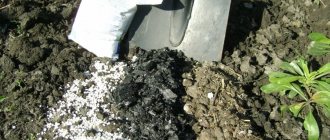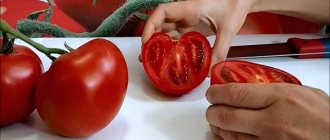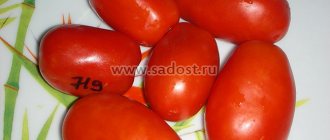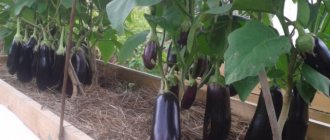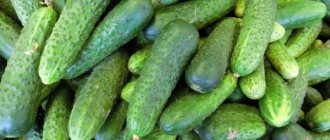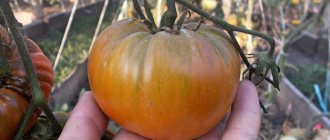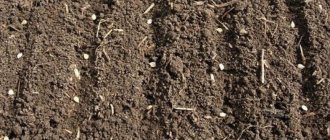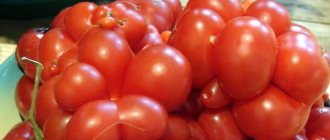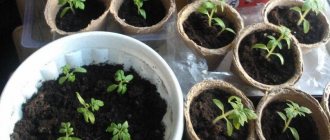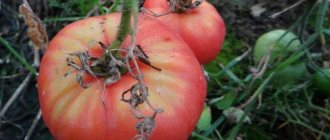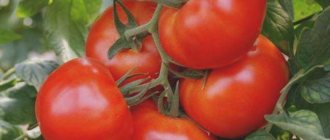We present to your attention the unusual Dutch tomato Solerosso. The early ripeness and high productivity of the crop have been appreciated by many Russian gardeners and are rushing to stock up on seed for the next summer season in advance.
There are many lovers of early tomatoes, and early tomatoes with a delicious taste want to try everything. In addition, agricultural technology for the entire growing season is so simple that even a beginner at a summer cottage will receive a decent harvest.
Description of culture
The hybrid was bred in Holland in 2006. Judging by the description and reviews, the Solerosso f1 tomato not only successfully took root in the Russian climate, but also managed to win many fans.
Distinctive features
The bush is determinate, 0.5-0.6 m high. The branches are moderately spreading, the foliage is medium, the leaves are medium-sized, dark green. The inflorescences are simple, one cluster bears up to 6 fruits.
The hybrid is early ripening, 90-95 days pass from the moment of sowing the seeds to full ripening. Due to its small growth, it is suitable for cultivation on the balcony at home.
Productivity is high, from 1 sq. m, up to 8 kg of fruits are collected, provided that 4-5 seedlings are planted per 1 sq. m. m.
Recommended for cultivation in open ground and in greenhouse conditions.
The species is highly resistant to the main diseases of the Solanaceae family. Due to early ripening, the crop is not affected by late blight.
Plants do not require obligatory pinching, but staking, despite their small growth, is necessary. The branches, strewn with fruits, cannot withstand the weight and bend to the ground. Due to contact with wet beds, the fruits may deteriorate.
Fruit characteristics
The average weight of ripe vegetables is 120-140 g, flat-round shape, rich red color, juicy pulp, moderate density. There are 6 seed chambers. The peel is thin but durable, the taste is sweet, without sourness or wateriness.
The purpose of tomatoes is universal: they are consumed fresh, used for pickling, canning and marinades. Ripe vegetables are also processed into tomato products.
Tomatoes are subject to long-term storage and long-term transportation. Thanks to the durable peel, they retain excellent presentation for 40 days, which allows entrepreneurs to use the hybrid for commercial purposes.
The photo shows Solerosso tomatoes.
Fruit characteristics
These fruits are ideal for canning for the winter, since their size corresponds to the neck of glass jars and when poured with hot marinade, the skin on the tomatoes does not burst.
| Index | Description |
| Tomato taste | Sweet and not watery. |
| Tomato weight | 85-100 gr. |
| Tomato color | Red. |
| Tomato shape | Flat rounded with slight ribbing. |
| Pulp | Moderately dense and juicy. |
| Skin | Thin, but protects the fruit from cracking. |
| Productivity | 8 kg. with m2. |
It is used in cooking and with the help of this hybrid you can prepare many homemade dishes:
- Salads.
- Side dishes.
- Lecho.
- First meal.
- Juices and purees.
This hybrid is versatile and easy to cultivate.
How to grow seedlings
Sowing seeds for seedlings begins 2 months before planting in the ground. As a rule, they are transplanted into a greenhouse 2 weeks earlier than into open beds. The main thing is to wait until the soil warms up to 15°C, otherwise the growth of young bushes will slow down.
Seed preparation
Since the crop is a hybrid, you won’t be able to prepare the seeds yourself - hybrids do not retain the parental genes in the next generation. Therefore, seed material will have to be purchased each time.
Purchased grains do not need processing; the manufacturer took care of everything himself. It is only necessary to assess the external condition of the planting material. To do this, lay it out on the table and carefully inspect it for visible defects: the grains should be light, without visible damage. Then check for emptiness by immersing it in a saline solution for 10 minutes.
Those seeds that float to the surface are empty inside, which means they are not suitable for planting. The remaining ones are washed with running water and dried.
Reference . To prepare a saline solution, dilute 1 teaspoon of salt in a glass of water.
To improve germination, planting material is treated with a growth stimulator and germinated on damp gauze for 2-3 days at a temperature of 25°C until sprouts appear. As the gauze dries, moisten it with warm water.
Container and soil
A nutritious soil mixture is prepared from garden soil, humus, peat and river sand in equal proportions. After thoroughly mixing all the components, add a little wood ash to the resulting mixture.
Reference . Ash enriches the sprouts with calcium and magnesium.
The prepared soil is disinfected to destroy pathogenic flora by pouring a hot solution of pink potassium permanganate. The soil is also disinfected in the oven for 15 minutes at 60°C.
After disinfection, the soil is poured halfway into the planting containers. Later, as the bushes grow, the remaining soil is poured into containers, so that the plants receive the necessary nutrients.
Plant in a common wooden box or in an individual container, at the bottom of which drainage holes are made so that excess moisture drains into them. Seedlings in individual containers do not need picking, so sowing in individual containers significantly simplifies the care of seedlings.
Sowing
The seeds are sown to a depth of 1.5 cm with a distance of 2 cm from each other, sprinkled with peat on top, slightly moistened with warm, settled water using a spray bottle and covered with film to create a greenhouse effect.
Then the containers are left in a warm room at a temperature of 25-26°C. At lower temperatures, the seeds will germinate later.
Seedling care
At the first shoots, the containers are moved to a well-lit place, on the windowsill, and the film is removed. Daylight hours for seedlings should be at least 12 hours. If necessary, add phytolamps.
Seedlings are watered with warm, settled water every week. After 5 true leaves appear, watering is increased to 2 times a week. After watering, the soil is loosened superficially, which helps the plants receive oxygen in the required quantity.
When 2 true leaves appear, the seedlings are picked and placed in separate containers. When picking, weak shoots are not replanted, as they will not be able to take root in open ground.
2-2.5 weeks before planting in the ground, the seedlings begin to harden, taking them outside for no more than 40 minutes. Gradually, the time spent in the open air is increased to 11-12 hours, while at the same time reducing the night temperature to 14°C.
Tomato agricultural technology
The heat-loving vegetable is cultivated using seedlings; this is the most suitable option for a hybrid plant. By preparing young seedlings in a timely manner, you can take full advantage of the growing season, obtain marketable products a little earlier, eliminate the first, most difficult weeding of small plants, and prepare the open ground for planting as much as possible.
Sowing of planting material is carried out in early March; for this it is necessary to prepare peat tablets or special seedling boxes with a soil mixture. The soil for young growth is prepared from several main parts: garden soil, good humus, river sand and peat. To properly nourish plants, it is worth adding a small amount of wood ash to the soil; it will nourish young plants with calcium, magnesium and other necessary substances. The finished soil mixture should be light and have moisture-retaining properties.
Ready boxes with soil mixture can be treated with a solution of potassium permanganate. The seeds also need to be taken care of in advance, checked for germination and treated with a preparation to stimulate growth. High-quality seedlings are a guarantee of obtaining a full harvest.
The planting material is deepened into the soil by 1.5-2 cm, then covered with a small layer of peat. Plantings must be well moistened and covered with plastic wrap. After 5-6 days, the first sprouts of the tomato crop will appear in the boxes, which should be kept in a warm place. Reviews from experienced vegetable growers say that the sprouts are strong and bright only if the planting material during development had sufficient illumination and timely watering.
You can keep young plants at home for 35 to 60 days; they are hardened off 10-12 days before transplanting.
It is important to note that Solerosso tomato seedlings take root well even with flowers and form fruits without shedding the ovary
The optimal temperature for germination of seedlings should be set within 23-25? C. Next, the heating mode is divided into night, when 14-15? C become acceptable, and daytime, during this period of time the temperature is maintained within 20-22? C. On cloudy days, seedlings must be illuminated with artificial lighting. A sharp decrease in temperature provokes a delay in the supply of phosphorus to plants, and the synthesis of nucleic acids is reduced. All these manifestations qualitatively reduce plant productivity.
The place for tomatoes in the garden is sunny and well ventilated. You should not select areas where rain moisture accumulates; the heat-loving crop develops better at higher elevations. The predecessor plants in the garden should not be potatoes, tomatoes and corn. Legumes, carrots, beets and cabbage are considered favorable successors for tomatoes.
Preparation of the soil substrate for plant transplantation is carried out in advance, in the fall
When preparing a plot for tomatoes, you should pay attention to the acidity of the soil. Vegetables are difficult to grow in acidic soil
Charcoal or chalk can make the soil substrate less acidic.
In the spring, fresh manure should not be added to the holes for planting seedlings. Excess nitrogen actively accumulates in vegetables, reduces the number of flowering clusters and has a bad effect on the human body. In autumn, it is customary to apply mineral fertilizers to the soil that are more difficult to wash out of the soil, such as phosphorus.
On the eve of planting young bushes, the soil is well moistened. Up to 3 plants are determined per 1 sq.m. On the first day, the young culture is covered with plastic wrap. The main care of plants in the beds consists of timely loosening the soil, removing sprouted weeds and controlling pests.
How to grow tomatoes
After 2 months, the seedlings are transplanted into the ground. By this time, 6-7 true leaves grow on each bush, and the height of the stem reaches 25 cm.
Landing
Planting pattern: 40 cm – distance between seedlings, 50 cm left between rows.
Planted in shallow holes after sunset or on a cloudy day. After planting, the holes are watered generously with warm, settled water and the young bushes are left to adapt to the new location for 1 week.
Reference . Tomatoes are not planted in the same place every season. Good predecessors are legumes, cabbage, carrots and winter crops.
Further care for the Solerosso tomato variety
Regular watering is established once a week, maintaining this regime until flowering begins. During the flowering period, the amount of moisture consumed increases. At least 3-5 liters of water are added to each bush.
Water in the morning or evening, when there is no direct exposure to sunlight.
Reference . The amount of moisture affects fruiting rates. Prolonged drought leads to the fall of the ovaries; with excess moisture, plant growth slows down.
After each watering, the soil is loosened, hilled up and weeds with roots are removed. On dry days, the beds are mulched with peat or straw. This helps the soil stay moist longer. In addition, mulch protects against the penetration of insect pests to the roots of plants.
Mineral fertilizers or organic matter are used as fertilizers for tomatoes. The main microelements consumed are phosphorus and potassium. Potassium is responsible for taste properties, and phosphorus regulates metabolic processes necessary during the growing season.
For potassium feeding, 30 g of potassium sulfate is diluted in 10 liters of water. Fertilizer is applied at the root after watering. Superphosphate provides the plant with phosphorus. It is diluted in a proportion of 40 g per 10 liters.
Feed three times during the growing season: during flowering, during the formation of ovaries and during fruiting.
During flowering, to stimulate the ovary, a solution based on boric acid (1 g per 10 l) is added to the fertilizing.
As organic matter, mullein infusion is used in a ratio of 1:10 or wood ash, from which infusions for irrigation are prepared.
Features of cultivation and possible difficulties
The culture does not require pinching, which significantly simplifies care. But you can’t do without a garter, despite the low growth of the bushes. The support is installed next to each plant and fixed immediately upon transplantation, thereby forming a strong and even stem. Additionally, the support protects young bushes from wind and precipitation.
Diseases and pests
The hybrid is immune to many diseases of the nightshade family. Due to early ripening, the tomato is not susceptible to late blight. However, young bushes are susceptible to gray rot. Prevention of this fungal disease is frequent loosening of the soil and moderate watering without stagnant moisture in the beds. In case of infection, the drug “Fitosporin” or 1% Bordeaux mixture will help to cope with the fungus.
Among the pests that are dangerous to tomatoes are slugs, mole crickets, aphids and whiteflies. An infusion of celandine will help get rid of whiteflies and mole crickets. Aphids are afraid of the soap solution used to treat plant stems, and ammonia diluted in water fights slugs.
Features of care
Like many other hybrids, the Solerosso F1 tomato combines unpretentiousness and demands for proper agricultural technology. Bad weather is no excuse for failure. The high potential yield of a tomato is realized only by the care of the owner, then the description of the variety as productive will correspond to reality. The main requirements of the Solerosso F1 tomato are good lighting, a moist root zone, and adequate nutrition.
Other nuances:
- The hybrid seeds have already been processed by the manufacturer. There is no need to do any pre-sowing manipulations.
- The seed material is quite small, well dried, so it can take quite a long time to germinate. Before emergence, it is necessary to maintain a temperature of at least +25 degrees.
- The seedlings should not be overgrown, since the variety is early ripening and bears fruit quickly. The optimal age of tomato bushes when planting in a garden bed is 50 days.
- 4 to 5 tomato plants are placed on one square meter.
- Pruning is done once, when the first cluster blooms. Remove all branches located under it. Remove shoots that grow from the ground at the base of the main stem.
- The soil in the root zone should always be moderately moist. Mulching will help a lot with this.
- Fertilizing with organic matter is mandatory for the Solerosso F1 tomato. If there is no manure or chicken droppings, they are replaced with prefabricated compost and herbal infusions.
- Protection against late blight is necessary. Sometimes proper crop rotation is enough. In open ground it is not so difficult to implement.
Hybrid Solerosso F1 fills the niche between Cherry tomatoes and large-fruited tomatoes. There are not so many short hybrids for open ground. They are convenient because they do not require massive supports and regular stepsoning. The Solerosso tomato consistently produces a solid harvest.
The nuances of breeding in open ground and in a greenhouse
Dutch culture adapts equally well to greenhouse conditions and open ground. When planting in closed structures, it is recommended to change the top layer of soil, since it is on the surface that pest larvae and pathogenic spores overwinter. Greenhouse soil is subject to mandatory disinfection.
The hybrid loves warmth, so the most productive cultivation is in regions with warm and temperate climates . When growing it in the middle zone, it is necessary to have covering material on hand in case of unexpected cold weather or prolonged rains.
Attention ! The greenhouse must be regularly ventilated, since fresh air destroys the spread of fungal spores and the usual habitat of many greenhouse pests.
The hybrid adapts not only to greenhouses and open beds, it is also successfully bred on the balcony. The compact size of the bushes and simple agricultural technology make it possible to get a decent harvest even at home.
Variety care
Solerosso F1 plants belong to the determinant type. This description of tomatoes refers to the ability of the bushes to limit their growth on their own when they reach a height of half a meter or a little more. There is no need to pinch the top at the end of the growing season. It is imperative to tie up the tomato stems, otherwise the bushes will break and fall under the weight of the harvest.
Solerosso is a tomato with abundant branching, but not too spreading. It needs to be pinched, but only up to the first flower cluster. Then the bush is allowed to develop freely. The foliage is not very large, but dense. Photosynthesis processes are very active, which works great for the tomato crop.
- The hybrid seeds have already been processed by the manufacturer. There is no need to do any pre-sowing manipulations.
- The seed material is quite small, well dried, so it can take quite a long time to germinate. Before emergence, it is necessary to maintain a temperature of at least 25 degrees.
- The seedlings should not be overgrown, since the variety is early ripening and bears fruit quickly. The optimal age of tomato bushes when planting in a garden bed is 50 days.
- 4 to 5 tomato plants are placed on one square meter.
- Pruning is done once, when the first cluster blooms. Remove all branches located under it. Remove shoots that grow from the ground at the base of the main stem.
- The soil in the root zone should always be moderately moist. Mulching will help a lot with this.
- Fertilizing with organic matter is mandatory for the Solerosso F1 tomato. If there is no manure or chicken droppings, they are replaced with prefabricated compost and herbal infusions.
- Protection against late blight is necessary. Sometimes proper crop rotation is enough. In open ground it is not so difficult to implement.
Hybrid Solerosso F1 fills the niche between Cherry tomatoes and large-fruited tomatoes. There are not so many short hybrids for open ground. They are convenient because they do not require massive supports and regular stepsoning. The Solerosso tomato consistently produces a solid harvest.
Immediately after picking the seedlings, they need to be watered. Watering is not required only if there are heavy rains or the soil is waterlogged. To get a good harvest, it is better to resort to drip irrigation as it will give the best results.
You can also use standard watering from a hose.
Further care consists of loosening the soil, tying it up and removing weeds. To reduce the load and get more free time, you can mulch the plantings. This will prevent the appearance of weeds and reduce the evaporation of moisture from the soil. Since the soil will not dry out, and the mulch will provide shelter for worms, aeration will be at the proper level.
As for the garter, it is better to do it when the berries are just beginning to set, so that the plants simply do not fall to the ground.
Solerosso tomato seeds are sold in processed form. They do not need to be soaked, pickled or fed with trace elements. The seeds are sown in a common box in moist peat soil, and then transferred to separate pots.
In the south, you can do without seedlings - sow the seeds directly into the garden bed.
Caring for plants in open ground consists only of watering and manual collection of pests.
Ultra-early / Low-growing
User rating: 5/5
Mid-early / Low-growing
User rating: 5/5
Early maturing / Low growing
Proper care of plants consists of the following:
- Timely watering with settled and warm water;
- Loosening the soil;
- Weeding;
- Fertilizing with organic and mineral fertilizers.
Harvesting and application
Early ripening allows you to get ripe tomatoes at the very beginning of summer. Vegetables of excellent taste are good not only for fresh consumption, but also for storing for the winter.
Fresh tomatoes are ideal in summer salads, a variety of appetizers, hot dishes and vegetable dishes such as stews or purees. Smaller tomatoes are used for pickling in their entirety. Also, tomato does not lose its taste in marinades, canned food and processed tomato products - ketchups, juices, lecho, adjika.
Ripe vegetables can be stored for a long time and can withstand long-term transportation for 40 days without losing their presentation. Entrepreneurs immediately saw this favorable factor and began to use the Solerosso tomato for commercial purposes.
Advantages and disadvantages
Let's start with the positive characteristics of the hybrid:
- simple agricultural technology;
- early ripening appearance;
- high adaptation to any climatic conditions;
- high fruiting rate;
- immunity to many diseases;
- does not require pinching;
- possibility of breeding at home;
- excellent taste of fruits;
- marketable condition;
- long-term storage;
- long transportation;
- universal application.
The disadvantages of the crop include the need to tie up low-growing bushes and purchase seeds for each planting.
Farmer reviews
There are no unsatisfactory reviews about the hybrid. Gardeners especially note the excellent taste and high quantitative indicator of the crop in any climatic zone.
Valentina, Chernigov: “I bought the seeds of the hybrid last year. The fruits are well suited for canning. I used them whole, which made it possible to quickly roll up the jars. The bushes bloomed profusely, even the tops were hard to see. I didn’t tame the stepson, but tied it up, watered it and fed it. It's a pity that you have to buy seeds every time. It's good that the price is affordable."
Maria, Rostov-on-Don: “I’ve been planting a hybrid for three years now. The stem is powerful, with a large number of brushes. There are never any problems with pollination and the yield is high. I constantly treat the plantings, so I have not observed blossom end rot or other diseases. When fertilized and watered, the fruits gain up to 150 g. The taste is excellent. This tomato has become one of my favorites and a permanent inhabitant of my garden bed.”
Fruiting
The description of the Solerosso F1 hybrid differs from other tomatoes by regular comparison with the growth rate of cucumbers. With sufficient watering, small tomato ovaries increase in size very quickly. They can be removed several times a week:
- The ripening period of the first tomatoes is early, already three months after germination. The harvest is growing together, wave after wave. The collection is carried out in several stages, throughout the season - until autumn.
- The ovary is numerous, very abundant. There are no empty flowers. Reviews from vegetable growers are unanimous: the Solerosso F1 hybrid blooms so that the leaves are practically invisible.
- The fruitfulness of the hybrid is high, despite the moderate size of the fruits and not too large clusters. During the season, 8–10 kg of tomatoes are obtained from one square meter.
Hybrid Solerosso F1 is considered unpretentious to weather conditions, but very responsive to a high level of agricultural technology. Regular watering and fertilizing contribute to a significant increase in tomato yield. The best fertilizer for this variety of tomatoes is organic.
